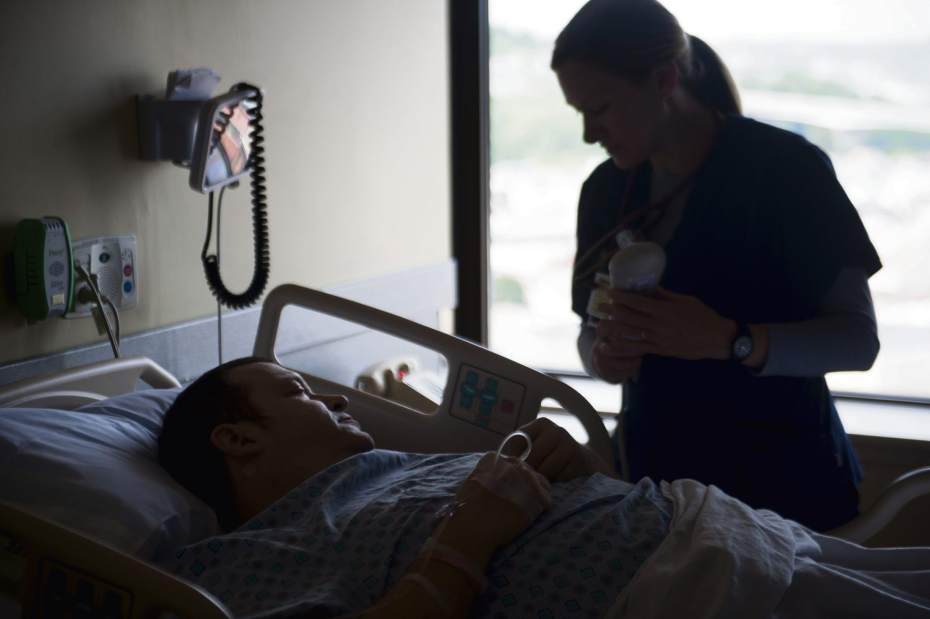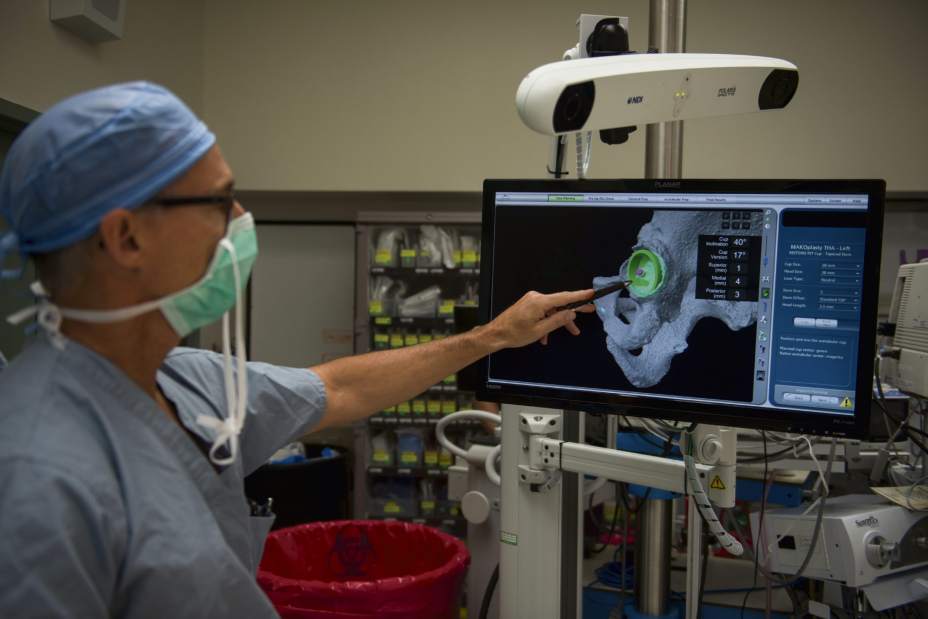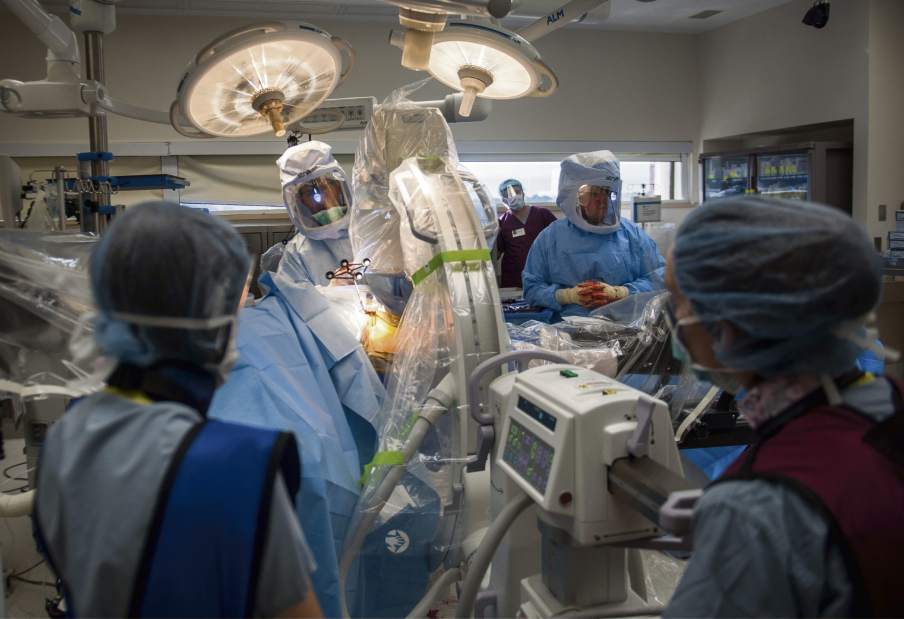Modern-day hip-replacement surgery has patients in, out on same day
It's 7:30 a.m. and a surgical team hovers above an operating table where Dave McCabe lies in an anesthetic slumber. They're cutting into his pelvis, pulling out his hip bone and grinding out a new socket for an implant.
There's plenty of blood, sawing noises and physical labor as they pull out his worn-out left hip.
Twelve hours later, without being admitted, McCabe rolls through the double doors of Pittsburgh's West Penn Hospital and heads home to Cranberry with his wife, Roseanne.
Eight days later, he joyfully walks laps around his driveway.
McCabe, 51, endured the evolving pain of hip arthritis for seven years until learning about a newer form of same-day hip replacement surgery in which patients go home shortly after the procedure.
"The doctors told me I'd know when it was time to get it done," McCabe told the Tribune-Review. "It was definitely time. I got to the point where the pain was so bad that I'd have to lift my leg up into my car, using my pants as a sort of handle. I was dragging it around everywhere. That was no way to live my life."
McCabe's nagging hip arthritis over the years gradually transformed a routine stroll around his subdivision into a painful journey. Sitting upright became a challenge and teaching kung fu — something he had done for several years — grew to be impossible.
His surgeon, Dr. Michael Seel of Allegheny Health Network, anticipated a rapid recovery from the procedure.
"I was pretty confident about coming through it well, all the way until about 20 minutes before going under," McCabe said. "Then I started getting nervous, thinking, 'What am I getting into? What if I come out and it's worse?' "
Seel, who operated on McCabe, is part of a growing group of surgeons executing same-day hip-replacement procedures throughout the United States. He replaced McCabe's left hip June 20 with a prosthetic titanium alloy and plastic ball- and-socket hip joint during a two-hour procedure.
Complete hip replacement has become more common with more than 300,000 procedures performed annually in the United States. The surgery is designed to relieve arthritic pain and help patients walk and exercise again with better range of motion. Average cost for a total hip replacement hovers around $30,000, according to a 2015 analysis by the Blue Cross and Blue Shield Association. The cost of the surgery at AHN is lower, officials said.
Excruciating pain
Besides teaching kung fu, McCabe is a motorcycle enthusiast and enjoys riding a recumbent bicycle. His arthritis prevented him from sitting for long periods of time and bike riding became increasingly painful.
During McCabe's surgery, Seel and a surgical team yanked out the head of his femur bone, or hip socket, using a bone saw along with some pushing and pulling. Then they installed the replacements, at times pounding them in with a hammer-like device. By mid-morning McCabe had a prosthetic hip socket and ball and stem implanted into his thigh bone.
Seel cradled the top of McCabe's femur bone, similar in size to a golf ball, in his hand after removing it.
"The cartilage is completely worn away to bone," he said, displaying the bone. "You can get a good view of where it's been rubbing — that's what arthritis looks like. When the cartilage wears out, that's when it really starts hurting."
Surgeons finished the procedure in about two hours and McCabe went home around 7 p.m., after spending a few hours in a recovery room with physical therapists and walking around a hospital wing.
The quick discharge stemmed from using a direct anterior surgical approach. Seel replaced McCabe's hip by going in through a small incision in the front of his leg. Doing so avoided the need to cut through muscle and tendons, a necessity when surgically entering alongside the hip or through the buttocks.
Other types of hip replacement operations can sometimes result in three-to-five day hospital stays.
There's also the consideration that infection rates are less likely for patients avoiding extended hospital stays.
"There's a lot less pain after surgery," Seel said. "We're going in through the front of the hip and separating natural muscle planes with our fingers to get down to the hip joint. There's a lot of pushing and pulling, but no cutting through muscle."
More studies needed
While some surgeons promote the anterior approach as less invasive, others contend its effectiveness cannot truly be judged until more data is available.
"There's not yet a lot of data to suggest that one approach is better than the other," said Dr. William Jiranek, an orthopedic surgeon who is president of the American Association of Hip and Knee Surgeons. "It's being sold to the media as the greatest thing, but the statistics that really need to be monitored are how many patients have to return for additional surgery within the first five years. It's still unclear what we're going to end up with. Installing the hip the right way, that is the key."
When operating on McCabe, Seel and his surgical team also gained assistance from a robot, of sorts. A robotic arm, manufactured by Fort Lauderdale, Fla.-based Mako Surgical Corp., guided doctors using a computer-generated, three dimensional model of McCabe's hip. Seel and his team mapped out the hip reconstruction via computer to precisely place the implant in the right spot.
The robotic arm helped surgeons limit drilling through bone to areas that are pre-determined in the surgical plan. It also provides pinpoint accuracy. An improperly placed implant could lead to problems such as fractures, dislocation, and leg length discrepancies.
"We are able to minimize these complications with the use of the surgical robot," said Seel, who is West Penn's director of orthopedic surgery. "The most important part is putting in the new component. We want this to last for him. He's a young guy. He's active. We're hoping the new hip lasts 20 to 30 years."
The robot technology still has some skeptics.
"The hospital systems that buy these robots, of course, are going to market them as fantastic devices to the public," Jiranek said. "There's still not enough data to prove this. What if the robot goes haywire? What if the robot gets it wrong? You have to say what's being done with robots is experimental."
McCabe, thus far, has no complaints. He returned to his warehouse manager job at Accredo Health Group, a specialty pharmaceuticals firm in Warrendale, on July 5, two weeks after surgery.
He quickly weaned himself off narcotic painkillers, tossed aside his cane after three days and was able to climb his staircase at home within 10 days.
"It feels fine; there's some swelling but I recovered extremely quickly," McCabe said at his office recently. "My co-workers were surprised that I was up and ready to go. I should have probably done this a long time ago."
Ben Schmitt is a Tribune-Review staff writer. Reach him at 412-320-7991 or bschmitt@tribweb.com.










